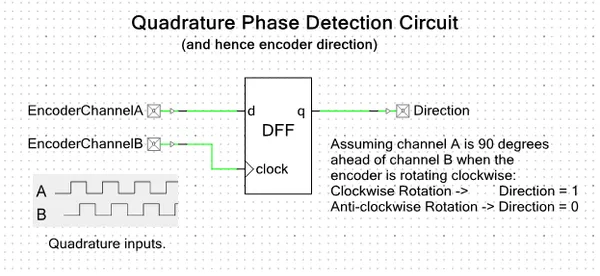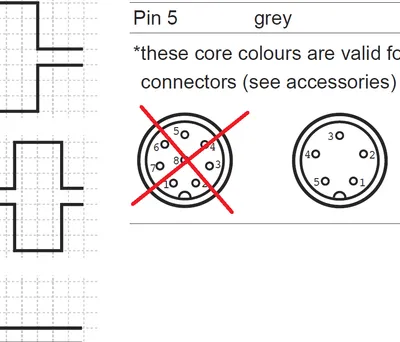Encoders
Encoders are devices that measure the position of something. The word ‘encoder’ typically refers to a rotational encoder, although linear encoders do exist. Rotational encoders usually connect to a shaft (or have provision for one).
Incremental Encoders
Incremental encoders are encoders that output ‘step-change’ data, rather than an absolute position of an object (however, incremental encoders can have an absolute output, that typically outputs one pulse per revolution, is called channel N, and can be used to determine absolute position).
A typical output signal for is called ‘quadrature encoding’. The encoder has 2 outputs (lets call them A and B), that both output a square wave with a certain number of pulses per revolution. The square wave on channel B is phase shifted by 90° with respect to channel A. From analysing the phase difference between the two signals, the rotational direction of the encoder can be determined. For example, in the clockwise direction, channel B would be 90° ahead of channel A, and in the anticlockwise direction it would be 90° behind channel A.
The phase difference can be determined in electronics hardware by using a ‘D type’ flip-flop. The output is 1 when the encoder is spinning in one direction and 0 when spinning in the other. See the schematic below.
Overflow Protection
Overflow of encoder inputs in embedded firmware is common, because of the large ranges covered by an encoder that is connected to object which is moving quickly for long periods of time (e.g. a spinning shaft at 6000rpm).
An encoder at 6000rpm, which has 1000 counts/rev and quadrature output, is outputting 400k state changes per second. At this rate, an int32_t variable on some embedded firmware which was counting every state change would overflow after only 89 minutes (assuming the variable started at 0, and it continued to spin in the same direction).
This means that if you want to track it for longer than 89minutes, you will have to use a larger numeric type (e.g. int64_t). This is fine if you are monitoring the state changes directly with interrupts fired from changes on the quadrature pins, but what about if you are using a quadrature peripheral that returns a 32-bit number?
One way is use software overflow protection, as shown below. This takes a overflow-is-possible 32-bit number and converts it into a 64-bit number. It uses probability to determine whether an overflow has occurred, based on the difference between the previous and current 32-bit value. The only requirement for this to work correctly is that it is called often enough that the encoder value cannot change more that half full-scale of the 32-bit number between two successive calls.
int64_t Encoder::Get64BitVal() { // Remember the prev encoder count static int32_t prevEncCount = 0;
// The 64-bit encoder value static int64_t encCount64 = 0;
// Read back 32-bit encoder value. int32_t currEncCount = QuadDecCpMotor_GetCounter();
uint32_t diff = 0;
if(currEncCount >= prevEncCount) { // Current value is greater than prev value. // Encoder is either going forward and increased, // or was going backward and wrapped from 0 back // to max diff = currEncCount - prevEncCount;
if(diff > INT32_MAX) { // Most likely scenario is that encoder was going in reverse // and overflowed from 0 -> max diff = (prevEncCount - INT32_MIN) + (INT32_MAX - currEncCount); encCount64 -= (int64_t)diff; } else { // Diff is correct encCount64 += (int64_t)diff; } } else { // Current value is less than prev value. // Encoder is either going backward, // or was going forward and wrapped from max // to 0 diff = prevEncCount - currEncCount;
if(diff > INT32_MAX) { // Most likely scenario is that encoder was going forward // and overflowed from max to 0 diff = (INT32_MAX - prevEncCount) + (currEncCount - INT32_MIN); // Add difference to 64-bit number encCount64 += (int64_t)diff; } else { // Add difference to 64-bit number encCount64 -= (int64_t)diff; } }
prevEncCount = currEncCount;
return encCount64;}Embedded Hardware Encoder Peripherals
The PSoC range of microcontrollers contain reconfigurable hardware that can used to make a hardware peripheral that counts quadrature output from an encoder. See the PSoC Component page for more information.
Datasheet Errors
The datasheet for the Baumer BHK series of incremental encoders has an error on the encoders wiring diagram. The pinout on page (3/4) for the 8-pin connector, used for the 05A series, is mislabelled. All the pin numbers around the circumference need to be rotated anti-clockwise by one pin. Pin 2 should be pin 1, pin 3 should be pin 2, e.t.c. Pin 8 remains the same.



